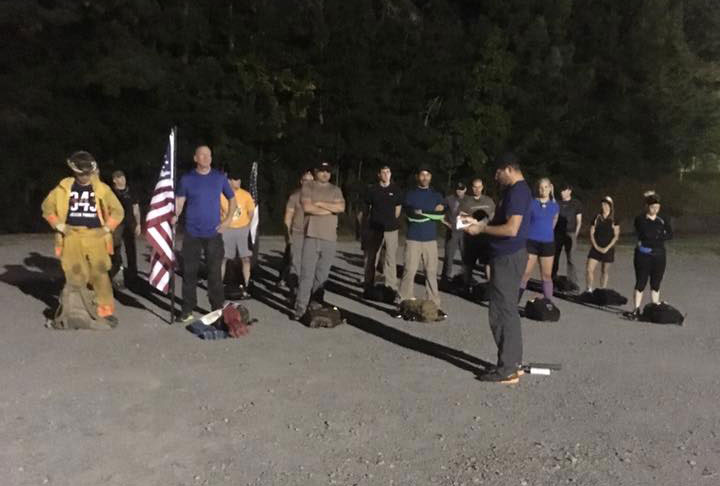
Photograph by Krissy Cook Williams
“Is anyone here carrying?”
That’s got to be the oddest, most unsettling, question I’ve ever heard before the start of a fitness event. But this wasn’t your everyday neighborhood 5K. It was the GORUCK Tough, a 12-hour, 15-mile, overnight team endurance event put on by former members of the military.
Our leader, known as the Cadre, wanted to know if anyone on our 18-person team was armed. Because that’s allowed, so long as you let the leader know. Perhaps this raises some questions in your mind, as it did for my friends and family, who in general were a bit bewildered by my decision to try a GORUCK Tough. Here, I’ll attempt to answer some of the most FAQ about the GORUCK experience, to demystify this admittedly over-the-top fitness challenge.
What is GORUCK, and what’s a Challenge?
GORUCK began as a backpack manufacturer in 2008 and expanded into endurance events as a way to employ veterans and acquaint civilians with military-style training while capitalizing on the public’s increasing interest in body-punishing challenges like Spartan Race and Tough Mudder.
There are three levels of GORUCK Challenges, with the “Light” taking up to five hours and boasting a 100 percent completion rate. I did one of those in May. The hardest, known as the “Heavy,” involves a 40-mile hump over 24 straight hours (one out of two participants makes it through this one). The “Tough” (with a 94 percent completion rate) sits in the middle, and might involve crawling through mud, standing nose-high in cold water while hoisting your backpack overhead, and doing burpees until you want to puke. For every challenge, you carry a rucksack stuffed with weights, a water bladder, a headlamp, and any gear you think you might need.

Photograph by Krissy Cook Williams
Oh, okay. So this is a race? With a course map?
Nope. It’s a team challenge, and there is no finish line. Going into it, you have little idea what will be expected of you. You don’t even know the start point until shortly before the challenge begins. Most Tough challenges start with a two-hour “Welcome Party,” which is code for a blistering bootcamp that can include bear crawls, lunges, planks, and push-ups. But sometimes the Cadre has other ideas. During my Tough on September 11, instead of doing the Welcome Party, we immediately started hoofing from Kennesaw to Marietta. And when one guy wanted to quit 20 minutes in, the team didn’t let him. There’s a “leave no man behind” mentality to these challenges.
You’re running with weights in your backpack??
For the most part, no. You’re rucking, which is basically fast walking while carrying stuff. Not only do you carry your weighted backpack, but the team has other things to haul, including at least one team weight (ours were two fire hoses and a weighted disc), a flag on a pole, and whatever else the Cadre decides you should lug. (We also lugged jerry cans of water, a second flag on a pole, a bag of water, a sandbag, and occasionally each other.) We did some jogging at the end—other GRTs (Tough finishers) have reported doing wind sprints with their packs on.
So it starts at 9 p.m. and finishes at about 9 a.m. When do you stop for dinner, and when do you sleep?
You don’t. No dinner, no sleep. Most of us just snacked on gels, pretzels, and other easily digestible food as the night wore on. There were a few breaks, during which we were allowed to take off our rucks and rest. But a lot of Cadres never let you take your pack off. And if you let it touch the ground, you’re in for some punishment burpees. After my Tough was over, I slept for five hours and then slept for another 15 that night.

Photograph by Krissy Cook Williams
Why? Why? Why?
That’s probably the most common question I’ve heard. Why would anyone want to pay upwards of $100 for this kind of physical punishment? For some, it’s a gut-check during what otherwise can feel like a pretty pampered existence. For others, it’s a way to honor the military and first responders (with our event being tied to September 11, we talked a lot about firefighters and even tried to simulate their climb in the second tower by walking more than 2,000 stairs). For me, it’s mostly about seeing what my body can do in its early 40s—how hard I can push, how strong I can get, and how much mental toughness I have.
Was someone actually carrying a gun at that Challenge?
Yup. Someone was packing at the Light I did, too, though she forgot to tell the Cadre—until a passerby at Piedmont Park found one of her cartridges on the ground.













